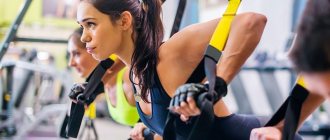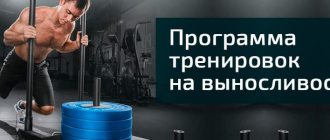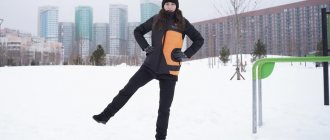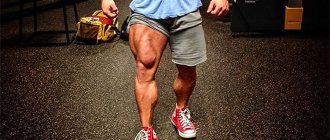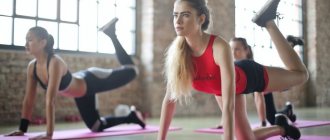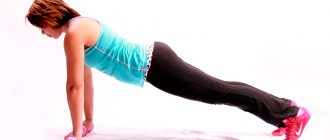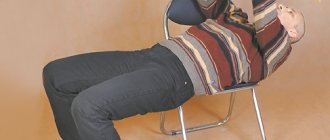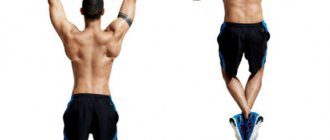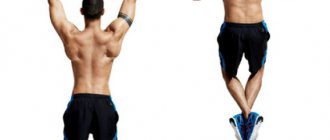Total Body Resistance Exercise or TRX for short are special sports loops. Athletes call this device T-Rex, which reflects the essence of the fact that it allows you to become powerful, strong, since you have to face one of the most aggressive representatives of the fauna that has ever existed on Earth.
What is suspension training?
During such training, special TRX suspension loops, developed by Navy SEAL, are used. Randy Hetrick, founder of TRX, had to stay in great shape for his job, but he often had to travel, so it was difficult for him to train well with traditional fitness equipment.
As a result, he made the first suspension trainer from scrap materials and parts of an old parachute. And his team has developed a large number of exercises using this equipment. They took gravity and body weight into account to create the ultimate full-body workout that develops strength, balance, coordination, flexibility and core strength.
How classes are conducted
TRX is a simple design that allows you to combine exercises of any complexity. To do this, just change the length of the belt and change the position. During training, this can be done several times and: perform simple and French presses; do push-ups; squat; pull up your knees; rotate the body; flex and extend your biceps. Suspended equipment is suitable for aerobic, strength, static and functional training. Work on hinges must be carried out under the supervision of a specialist. He will definitely clarify the purpose of the visit and the presence of contraindications. Exercise on the simulator eliminates axial load on the spine, therefore it is considered absolutely safe.
What is special about training with TRX loops?
TRX loops are truly useful sports equipment. Unlike traditional gym equipment, TRX loops engage the muscles of the entire body during a workout. This training includes a large number of dynamic movements in different planes.
Most exercise machines have seats or some other support. Just performing the exercise in a seated position reduces the likelihood of developing the stabilizer muscles needed for proper posture and injury prevention. Loop workouts work multiple muscle groups at once to maintain stability with each exercise.
Every day the human body performs various movements in different planes: forward and backward, side to side, turns and rotations. TRX loops allow the body to perform all of these movements. Classic exercise machines are designed mainly to work in one plane, which can lead to overload of a certain muscle group and even injury.
To train different muscle groups and perform movements in different planes, well-developed coordination of movements is required. Exercises with TRX loops improve the nervous system's ability to coordinate movements and make them more efficient.
General recommendations
A huge role in the effectiveness of a particular back exercise is played by the mental attitude of the athlete and his neuromuscular activity. With any pulling movement, the emphasis should be placed not on the arms and their bending, but on raising the elbows beyond the line of the torso. Many professional trainers claim that you can only load your back if you completely “turn off” the arm muscles. You need to imagine that your palms are just hooks and attachments for pulling weights.
This execution of movements allows you to redirect the lion's share of neuromuscular impulses to the back muscles, which are practically not involved under normal conditions. A striking example: the rhomboid and serratus posterior muscles.
Benefits of training with TRX loops
Fast and effective workouts for the whole body
There is no need to go somewhere to train, because you can do it right at home. To do this, you only need TRX loops.
Increase muscle endurance
During such training, you can easily move from one exercise to another without changing equipment, and the muscles will constantly work, increasing their endurance.
Suitable for all fitness levels
TRX loops can be attached in a way that is convenient for a person and adjusted to suit his physical capabilities. This is done to make it easier to adapt to a new training style and equipment.
Convenient to use everywhere
TRX is convenient to take with you everywhere, as they weigh about 1 kg. In order to attach them, you will need a door or a tree, and after that you can safely train anywhere. TRX loops are an excellent exercise machine for those who do not sit still.
Relatively inexpensive
The loops cost $200, which is much cheaper than buying a full body workout kit. TRX loops can give you everything you need for an effective workout.
A few words about contraindications
Before you start training, you should definitely consult your doctor. This must be done so that the trainer can choose the right set of exercises. People suffering from cardiovascular diseases and respiratory problems should be especially careful. Persons who have undergone operations should refrain from such stress. Also, loops are not suitable for those who have chronic problems with:
- liver,
- kidneys,
- spine.
You cannot attend classes if you have high blood pressure, inflammatory processes in the body, exacerbation of hemorrhoids or epilepsy.
Maximum benefits from training with minimal effort
One of the biggest benefits of loops is their incredible ability to modify exercises for beginners or add complexity for professionals. You can choose exercises that are right for you. Here are some ways you can turn a beginner's workout into a more challenging workout as you get stronger and fitter.
How to achieve success and progress with TRX:
Change the position of your legs from wide to narrow or even perform on one leg
The wider your legs are, the stronger and more stable the base for performing the exercises. If you make the distance between your legs smaller or perform exercises while standing on one leg, then your core muscles will work harder to prevent body rotation and maintain balance. Once you get to the point of performing single-leg exercises, you can change the position of your free leg to make the exercise even more challenging and test your coordination. Here are some options: raise your knee, extend your straight leg forward and keep it in the air, or move your raised leg to the side.
Change your body angle to change the resistance
The more horizontal the body is to the floor, the more difficult the exercise becomes. This approach to performing the exercise will force you to work against your body weight and gravity, increasing resistance. To make the exercise easier, assume an upright position. This will reduce resistance and allow you to focus on the technique of performing the exercise.
Change the pace
Move faster to get your heart rate up. With this approach, the workout takes on the features of cardio and also increases muscle endurance. You can either perform a certain number of sets and repetitions at a fast pace, or monitor the number of repetitions completed in one minute.
Shorten the break between exercises
Try to perform one exercise after another without resting. This will also improve muscle endurance.
Add Plyometrics
To increase the intensity of your workout, add jumping jacks to your regular exercises (jumping jacks, squats). This will add a touch of cardio to your workout.
These were the easiest and fastest ways to make your loop workout harder in just a few seconds. You can also add more challenging exercises to your workout to increase the intensity.
Warm-up
- Head tilts (clockwise and counterclockwise) – 10 repetitions
- Head rotation (clockwise and counterclockwise) – 10 repetitions
- Shoulder rotation (clockwise and counterclockwise) – 10 repetitions
- Wrist rotation (clockwise and counterclockwise) – 10 repetitions
- Waist rotation (clockwise and counterclockwise) – 10 repetitions
- Side lunges (right and left) – 10 repetitions
- Ankle rotation (clockwise and counterclockwise) – 10 repetitions
“Jumping Jack” or “Jumping Star” (jumping with changing the position of the legs – approx. per.) (clockwise and counterclockwise) – 10 repetitions
Basic workout with TRX loops for the whole body
This is a basic full body picture workout with loops that a beginner should start with. Perform these exercises in 3-4 sets. Remember, the sharper the angle between the body and the floor, the more difficult the exercises will be. To modify any exercise, decrease the angle or place your bent knee on the floor for more support.
TRX squats
Take the loops in your hands, stand facing the fastening, place your feet slightly wider than shoulder width. Knees and toes point slightly to the sides. Pull the loops to waist level, bend your elbows slightly. Perform a squat with emphasis on your heels, do not lean back or round your back. Focusing on your heels, return to the starting position. Perform 15-20 repetitions.
TRX lunges with a step back
Stand facing the wall with your feet together. Hold the loops in your hands at waist level, bend your elbows. Take a step back with your right foot, your body weight should be on your left foot. Focusing on the heel of your left foot, return to the starting position. Perform 15-20 repetitions on one leg, then the same on the other.
TRX side lunges
Stand straight, feet together, keep the loops in front of you. Step your right leg out to the side and squat into a lunge. It should be bent at the knee at a right angle. Keep your left leg as straight as possible to feel the stretch in your inner thigh muscles. Focusing on the heel of your right foot, return to the starting position. Perform 15-20 repetitions on the right leg and the same on the left.
TRX traction
Holding the loops in your arms outstretched, lean back slightly. Tighten your core and don't let your hips sag back. Lift your toes so that the emphasis is on your heels. This will be the starting position. Squeeze your shoulder blades together and row the loops toward your forehead, moving your torso to a vertical position. Slowly return to the starting position. Perform 15-20 repetitions.
TRX chest presses
Turn your back to the hinge fastening. Stand on your toes, stretch your arms with the loops in front of you, palms down. Bend your elbows as if you were doing a push-up, keeping your elbows in line with your shoulders. Using your chest muscles, straighten your elbows and return to the starting position. Perform 15-20 repetitions.
TRX bar
Lower the loops a little lower so that they are somewhere at the level of the middle of the knees. Lie on your stomach and place your feet in the loops, toes pointing down. Place your hands on the floor directly below your shoulders and push yourself up into a push-up position. Hold the position for about 30-60 seconds, tighten your abdominal muscles and do not let your hips sag.
Exercises for chest and arms
- TRX push-ups (Push up)
- Lat pull
- Tricep extension
- Bicep curl
- Raising arms to the sides (Reverse fly)
- Squat
- Calf Raise
- Pistol squat
- Floating Lunge
Recommended reading on the topic of TRX training and exercises:
- TRX training for all parts of the body with video
- Review of TPX loops: pros and cons, review of applications
Training with TRX loops for advanced levels
This workout includes a few more difficult exercises, but beginners will be able to master them. Perform this workout in a circuit for 3-4 sets. You can also simplify your workout by adding a few exercises from the plan above.
Single leg squats
Facing the wall, hold the loops so that your elbows are bent and your elbows are near your waist. Extend your left leg forward, keeping your body weight concentrated in your right leg. Bend your right leg at the knee and sit back as if you were sitting in a chair. Try to maintain your balance and not lean too far back. Focusing on your right heel and engaging the muscles of your right leg, return to the starting position. Repeat 15-20 times on the right leg and then on the left.
TRX push-ups
Place your feet in the loops and assume a plank pose. Your arms should be in line with your shoulders. Perform a push-up, keep your hips sagging, and tighten your core muscles. Perform 15-20 repetitions.
TRX crunch
Take a position similar to the TRX plank exercise with your hands directly under your shoulders. Without moving your shoulders, tighten your abdominal muscles and bring your knees toward your chest. Return to plank position and perform 15-20 repetitions.
TRX lunges
Bring both loops together and place your left foot in the loop, turning your back to the wall. Take a small step forward with your right foot and bend your knee into a lunge. The weight of the body should be on the heel of the right foot. Focus on it and tighten your buttock muscles to return to the starting position. Do 15-20 repetitions on your right leg, and then the same on your left.
TRX forward bends
Kneel with your back to the wall. Hold the loops straight out in front of you, palms down. Brace your core as if you were in a plank position and raise your arms overhead. Keep your shoulders relaxed and lean forward. Using your back muscles and rectus abdominis, return your arms and body to the starting position. Perform 15-20 repetitions.
Leg bends at the knees
Lie on your back and place your heels in the loops. Keep your legs straight, lift your buttocks off the floor, placing your body weight on your shoulder blades. Using your inner thigh muscles, bend your knees and bring your heels toward your buttocks, lifting your hips even higher. Straighten your legs forward and bend your legs again without lowering your hips. Perform 15-20 repetitions.
Anatomy of the back muscles
Before you begin back exercises, you need to know which muscles are included in this important group. The components of the spinal musculature perform various functions. Understanding the principles of anatomy and physiology will help you determine the best exercises for a balanced, effective routine.
The main muscles of the back are listed below.
Latissimus: located on the sides of the back from the armpits to the lower back and covers the ribs. Well-developed muscles are shaped like wings. Perform the following functions:
- shoulder adduction
- shoulder extension
- shoulder internal rotation.
Trapezius: Forms a large, paired, diamond-shaped muscle in the upper back. Responsible for the work of the shoulder girdle, consisting of shoulder blades and collarbones. They are divided into three groups that perform different functions:
- upper section – raising the shoulder girdle
- middle section - retraction of the shoulder blades
- lower section – lowering of the shoulder girdle
Rhomboids: Small muscles located between the shoulder blades under the middle trapezius muscles. Together with the trapezius muscles, they are responsible for bringing the shoulder blades together.
Erector spinae muscles: located on the sides of the spine. Their main function is to straighten the body. They help support your back when doing deadlifts, squats, and bent-over rows. Weak erector spinae muscles are a common cause of lower back pain. You can fight it by strengthening these muscles.
Workout plan with TRX loops for beautiful and slender legs
This workout plan features a variety of lunge variations. These exercises target the muscles of the legs, core, arms and shoulders. They can be done as a stand-alone circuit workout, or you can add a few exercises into your regular workout plan. They will help increase your level of physical fitness and add elements of cardio to your workout.
Perform the following exercises as a circuit workout for 3 sets.
TRX lunges with arms raised overhead | 6 reps on both sides
Holding your arms above your head during lunges makes the exercise more difficult, increases your heart rate, relieves tension in the shoulder girdle, and works your core.
Hold the loops above your head with your back to the wall. Hands should be shoulder-width apart in line with your forehead.
Take two large steps back to give yourself room to lunge forward. The loops must be taut.
Now take a step forward and bend both knees so that the back knee almost touches the floor. At the end point of the lunge, your arms should be in line with your hips. Press the heel of your foot forward to return to the starting position. Then lunge with your other leg.
Alternate your legs and keep your arms overhead at all times. Try to maintain tension in the loops throughout the entire exercise.
If your shoulders are very weak or there is discomfort during the exercise, place your arms in a Y or even T shape to the sides. Once you warm up and improve mobility in your shoulders, it will become easier to hold them overhead.
TRX split lunges | 8 reps on each leg
If you have problems with your hip flexor muscles, then this exercise will help develop them. Solve two problems with one exercise: stretch your muscles and strengthen them.
To begin, place one leg in the loop with your back facing the wall. Lower your leg lower in the loop to tighten it. Move further away from the loop so you can bend your front knee to a 90-degree angle. Keep your back leg straight throughout the exercise, even when lifting up.
Perform 8 repetitions on one leg first, then switch legs.
Try not to put weight on the back of your leg. Focus on the up and down motion rather than the lunge itself.
TRX lunges with squats | 10 repetitions on each leg
Squat lunges are similar to Bulgarian split lunges. Only instead of placing your foot behind you on the step, you place it in a loop, which will help you maintain your balance as you perform the exercise. This is a more complex and advanced variation of the exercise.
To begin, stand with your back to the wall and place one foot in the loop, toe down. Step away from the loop so that it tightens and the back knee bends at a 90-degree angle before starting the lunge.
Perform 10 repetitions on one leg, then switch to the other leg.
If the body leans forward a little, then it’s okay, it will be easier to maintain balance. Try not to tilt your head and shoulders forward. Place your hands on your hips to maintain proper posture.
TRX samurai side to side lunges | 10 reps, alternating legs
To tone your inner and outer thighs, try this lunge variation.
Take the connected loops in your hands, step back so that the loops tighten and your arms straighten, spread your legs wide. The whole body should be slightly tilted back.
Now start bending one knee. Push your butt back, pressing into your heel, and lower into a lunge. The second leg should be completely straight. The toes of both feet should be pointed forward. Return to the starting position. Then do the same with the other leg.
The goal of the exercise is to feel the tension in the muscles of the inner thigh without lifting your heels off the floor. If your heels come off the floor, then you don’t need to squat so low.
TRX lunges with alternating legs in the air | 6 reps, alternating legs
Plyometric movements quickly tone your legs, but without the TRX loops it will be difficult to bounce off the floor. Help yourself with your hands when jumping.
Stand facing the wall and take the hinges in your hands; they should be connected to each other with a fastener. Step back with one leg and bend both knees into a lunge. Your arms should be slightly bent at the elbows.
Jump up, pulling the loops slightly toward you. Switch legs in the air and land in a lunge with your other leg in front. Land softly and try to land on your heels rather than your toes.
The harder you pull on the loops as you jump, the easier it will be on your legs. Don't overdo it, or you might lose your balance. The legs should do most of the work, and use the loops to help.
TRX Lunges with Knee Raise | 8 reps on each side
TRX lunges with knee raises will get your heart pumping and also strengthen your rectus abdominis muscles.
Grab the handles of the loops and take a huge step back. Lower into a lunge. The knee at the back should be almost on the floor, the knee at the front should be bent at a right angle, and the arms should be straight. With your foot on the front, bring your back knee to the hinges. Raise it above hip level, tighten your abdominal muscles, exhaling all the air from your lungs.
Perform all repetitions first on one leg, then on the other.
Try to follow this workout plan quickly, then it will turn into an easy cardio workout and will also be good for your abdominal muscles!
Three reasons to get involved
There are several reasons for practicing this type of yoga.
- Exercises relax the body well and help improve physical and psycho-emotional well-being. Normalizes sleep. They bring the body into a cozy state, like in a child’s cradle: a state of comfort, serenity. Relieves stress and psychological pressure.
- Reduces stress on joints. The hammock is made of soft, lightweight, elastic material, so it is easy to perform those asanas that are difficult on the floor (due to pain in the knee joints, for example).
- Increases the level of brain activity. Inverted asanas help normalize blood circulation and also allow you to look at the surrounding space in a new way.
